Archive for April, 2012
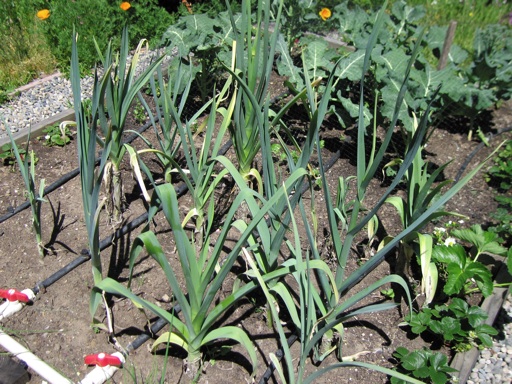
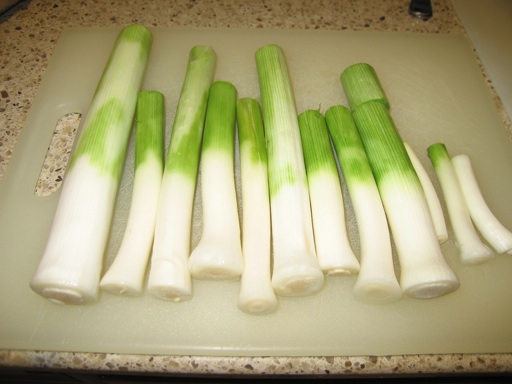
Last spring, I planted leek seeds for the first time in one of our raised vegetable garden beds. Most of the seeds sprouted within a month. Late last summer, I dug them up and transplanted them to a different raised bed where there was more room for them to grow. They didn’t show any sign of shock after the transplant, as far as I can remember. In any event, they continued to grow through fall, winter, and early spring this year.
Within the past few weeks, they started to “go to seed” (first picture above taken yesterday). That is, they started to grow long stalks with flower buds at the tip, indicating it was harvest time. Yesterday, I pulled them up, and then cut off their roots and leaves (second picture above). They weren’t any where near as large as the leeks I see in grocery stores, but I guess size doesn’t matter if you are just going to slice them. Today, I made potato leek soup for the first time with my home grown leeks. The soup turned out really well. Here is the recipe:
1 Lb. leeks cleaned and sliced
3 potatoes skinned and diced
2.5 TBS butter
3.25 cups chicken broth (may be low sodium)
1/4 cup dry vermouth
1/4 tsp white pepper
1 cup half and half
salt to taste
Saute leeks in butter and a pinch of salt for about 20 minutes until soft. Add potatoes, pepper, vermouth, and broth, bring to boil, and reduce to simmer for 30 minutes. Puree with 1/2 and 1/2. Salt and pepper to taste.
April 22 2012 | Leeks | Comments Off on Leeks
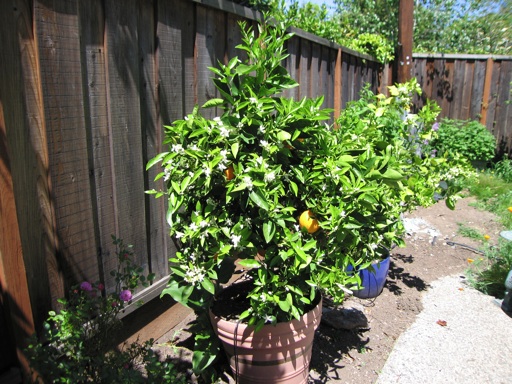
This is a photo of a Washington navel orange bush that I used to have growing in the ground. It is the same plant that I wrote about in a post two years ago complaining how it was dropping leaves when I fertilized it. I later talked to a citrus grower who convinced me that it was dropping leaves, because I watered it too much after I fertilized it. I didn’t think I was overwatering it, but it occurred to me that the ground there may not be draining quickly because of its clay-like soil. I figured our orange didn’t like that spot, because when I did irrigate it, the water may have been sitting there too long.
So I dug the plant up and transferred it to a large container. Since I moved it to the container, it has thrived. It hasn’t dropped leaves like it did when it was growing it the ground. Instead, it has grown considerably, and its leaves are a healthy looking dark green color. Just in the past few weeks, it has developed a flush of new green growth, and it is full of blossoms. It also has about 10 large fruits on it that are nearly ripe. It obviously likes being in the pot better than in the ground, and I think it’s because the pot drains water more effectively. Although, it does need more frequent watering in the container.
I also have a small page mandarin orange bush that I had growing in the ground in a different part of our yard for a few years. While it was in the ground, it often dropped many of its leaves like the orange. It also had many yellow leaves even after fertilizer applications, and it didn’t grow much. Last year, I transplanted it to a container. Since then, I’ve noticed it improving. It’s growing more, it’s not dropping leaves, and its leaves are much greener now than they were when it was growing in the ground. It’s also just beginning to bloom now.
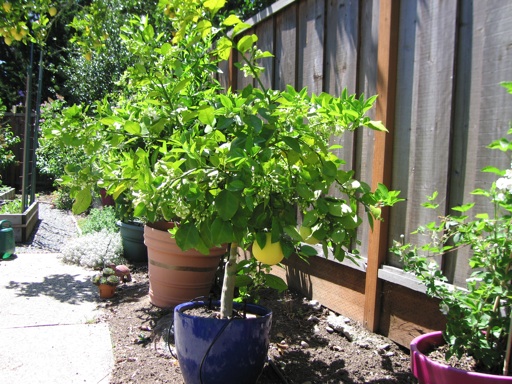
This is a photo of an Oroblanco citrus bush we have growing in yet another container. We bought it from a nursery just over a year ago. It has two fruits on it, which I am anxious to taste. So far it also seems to be doing well in a pot.
Last winter, the temperature here dropped down to 26.5 F on two nights, but none of our citrus plants had any noticeable signs of freeze damage. Even the three citrus bushes we have in pots which were outside and uncovered didn’t show any damage from the freezing weather. So far, the orange fruits I have picked are also not showing freeze damage. Cold damaged citrus typically has dried out pulp.
April 21 2012 | Oranges and Oroblanco | Comments Off on Citrus in Containers
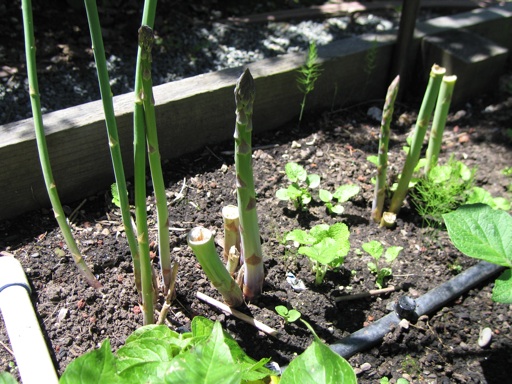
This spring, I harvested our first asparagus spears. I first planted 5 bare root Mary Washington asparagus near the edge of one of our raised beds 3 years ago. I planted them about 12 inches apart, but they are not near other plants that would crowd or shade them.
I let the asparagus grow without harvesting the spears for the first two seasons, as many publications on asparagus recommend. This year is the first year they have produced more than a few spears that are worthy of eating. I have cut about 15-20 spears in the past month. The spears first starting appearing in our garden in early March. I have let a few spears on each plant grow into ferns so that each plant is able to produce at least some sugar for the roots. I will probably continue to harvest some of the spears for a few more weeks before letting them all grow into ferns.
Once asparagus spears grow into ferns, they can become an annoyance as they often fall over into other plants or in a garden pathway. When they fall over, I usually trim the ferns back to keep them out of the way.
I have never fertilized our asparagus. Because they are growing in a raised bed filled in with compost, I don’t think they need fertilizer, especially because asparagus are long-lived perennials that have many years to grow into maturity. Although, I do water them every few days during our spring-to-fall dry season.
April 20 2012 | Asparagus | Comments Off on First Asparagus
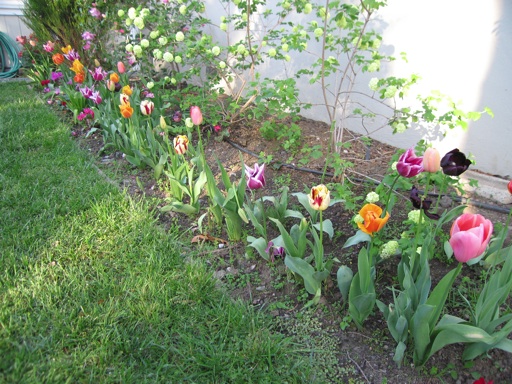
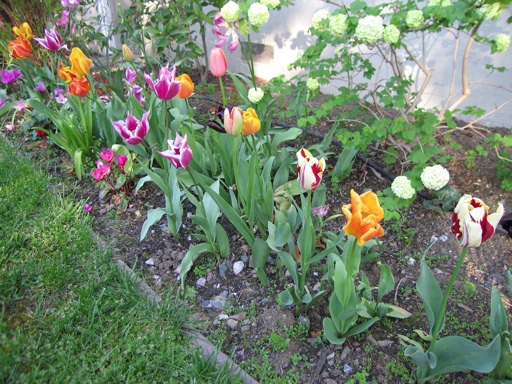
Tulips are one of the most attractive springtime flowers for the few weeks that they’re in bloom. Tulips come in many different colors and different mixes of colors on a single flower. I think they make a particularly eye-catching display when different colors of tulips are grown together. Each bulb only generates one flower per year, though.
I grow tulips as short lived perennials. I’ve been planting tulip bulbs in the same garden bed (shown in the pictures above) every fall for about 4 years. Each bulb blooms for 1 to 3 spring seasons before it fades away and eventually dies. The Bay Area is probably not cold enough to be an ideal climate for tulips, so I replenish our tulip bed every fall with a new planting of bulbs. It seems much easier than digging up old bulbs and refrigerating them as some people suggest. Last fall, I planted about 50 bulbs that included a mix of different colors.
I don’t fertilize our tulips, and I rarely water them. Usually, rains in winter and early spring are enough for them. This past winter was especially dry, so I did water the bed a few times.
April 15 2012 | Tulips | Comments Off on Multi-Colored Tulips
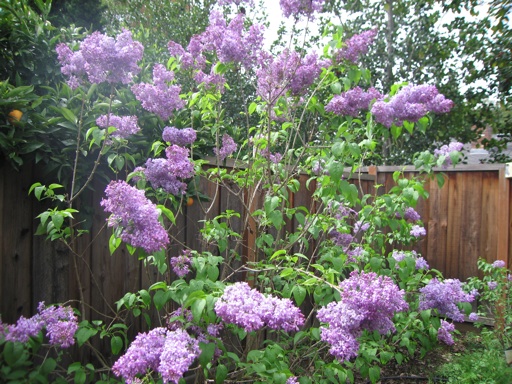
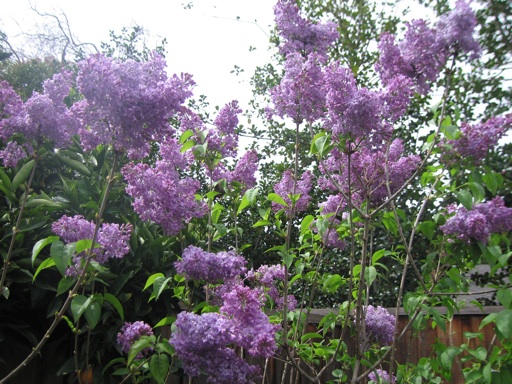
The lilacs in our yard have been in bloom for the past two weeks, but they look to be at their peak right about now. These are photos of one of our Lavender Lady lilac bushes, which is more full of flowers than it ever has been. The fragrance of lilacs is really like no other flower. The fragrance is so strong that I can smell it at a distance of about 10 feet away. We are also growing California Rose and Blue Skies (descanso hybrids for mild winter climates) and Sensation lilacs, but our Lavender Ladys get the most flowers by far each year.
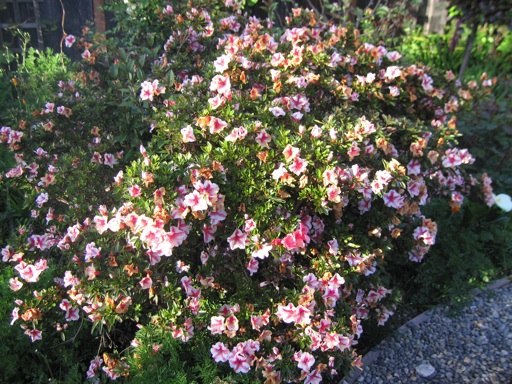
This is a photo of our one of our azalea bushes, which has been growing in our backyard since before we moved in. It is a well established bush at this point that doesn’t seem to need much care. Azaleas of course prefer partial shade, but this one seems to be doing well in full sun.
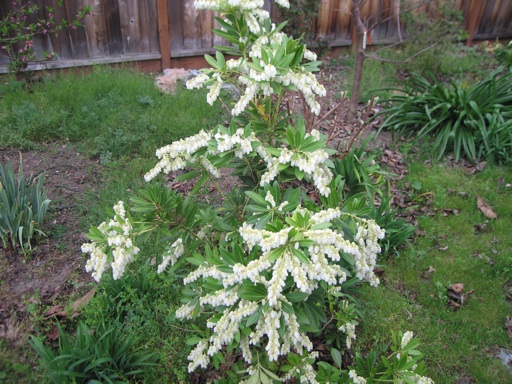
I can’t remember the name of this plant. It’s a small perennial bush. My mom gave it to me about 2 years ago. It has been flowering in our yard for the past 6 weeks, but its flowers are starting to fade now. This photo was taken about 3 weeks ago. Its flowers look like tight clusters of ‘lily of the valley,’ but it’s leaves are very distinctive and evergreen.
April 01 2012 | Lilacs and Rhododendron | Comments Off on Early Spring Flowers










